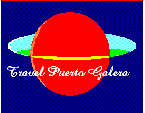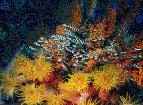|
Coral Garden
 Located just to the West of Medio Island Located just to the West of Medio Island For all divers including the beginner For all divers including the beginner The conditions are usually calm, although during the monsoon season it can get rough The conditions are usually calm, although during the monsoon season it can get rough The best time to dive is on flood tide when visibility can reach 20 meters / 65 feet The best time to dive is on flood tide when visibility can reach 20 meters / 65 feet The Maximum depth is 12 meters / 40 feet The Maximum depth is 12 meters / 40 feet Stony and soft corals from about 3 meters / Stony and soft corals from about 3 meters / 9 feet
 Excellent for snorkeling Excellent for snorkeling Excellent for underwater photography Excellent for underwater photography
|
The Pink Wall
 Located at the southern headland of Escarceo Point Located at the southern headland of Escarceo Point For all divers including the beginner For all divers including the beginner The conditions are usually calm during flood tide, but now and then rough with a strong current The conditions are usually calm during flood tide, but now and then rough with a strong current The best time to dive is on flood tide when visibility can reach 15 meters / 50 feet The best time to dive is on flood tide when visibility can reach 15 meters / 50 feet The maximum depth is 12 meters / 40 feet The maximum depth is 12 meters / 40 feet The Pink Wall is an overhanging wall at 10 meters / 30 feet and is covered with pink corals and cup corals The Pink Wall is an overhanging wall at 10 meters / 30 feet and is covered with pink corals and cup corals Excellent for night diving Excellent for night diving
|
|
|
The Hill
 Located at the southeast end of the Batangas Channel Located at the southeast end of the Batangas Channel For all divers including the beginner For all divers including the beginner The conditions are usually calm, but they can occasionally get rough with strong currents The conditions are usually calm, but they can occasionally get rough with strong currents The visibility reaches 20 meters / 65 feet The visibility reaches 20 meters / 65 feet The maximum depth is 18 meters / 60 feet The maximum depth is 18 meters / 60 feet Small reef fish, soft corals and sponges abound Small reef fish, soft corals and sponges abound
|
Hole in the Wall
 West of Escarceo Point West of Escarceo Point For all divers including the beginner For all divers including the beginner The conditions are sometimes choppy with strong currents, but it can be very rough with fierce currents The conditions are sometimes choppy with strong currents, but it can be very rough with fierce currents The visibility reaches 25 meters / 80 feet The visibility reaches 25 meters / 80 feet Maximum depth is 18 meters / 60 feet Maximum depth is 18 meters / 60 feet A very popular dive site. One swims through a hole and reaches abundant marine life with corals in all the beauty and glory A very popular dive site. One swims through a hole and reaches abundant marine life with corals in all the beauty and glory
|
|
|
La Laguna Point
 West of Sabang West of Sabang For all divers including the beginner For all divers including the beginner The conditions are usually calm with a gentle current The conditions are usually calm with a gentle current The visibility reaches 20 meters / 65 feet The visibility reaches 20 meters / 65 feet Maximum depth is 15 meters / 50 feet Maximum depth is 15 meters / 50 feet A short wall from 12 meters (40 feet) to 15 meters (50 feet) with colorful crinoids, nudibranches and a great variety of small reef fish A short wall from 12 meters (40 feet) to 15 meters (50 feet) with colorful crinoids, nudibranches and a great variety of small reef fish
|
Manila Channel
 Between Medio and Boquete Island Between Medio and Boquete Island For all divers including the beginner For all divers including the beginner The conditions are usually calm with a gentle current The conditions are usually calm with a gentle current The visibility reaches 20 meters / 65 feet The visibility reaches 20 meters / 65 feet Maximum depth 18 meters / 60 feet Maximum depth 18 meters / 60 feet An abundance of stony and soft corals along a 3 meter / 10 feet drop-off An abundance of stony and soft corals along a 3 meter / 10 feet drop-off
|
|
|
Sabang Point
 East of Sabang East of Sabang For all divers including the beginner For all divers including the beginner The conditions are usually calm with a slight current The conditions are usually calm with a slight current The Visibility reaches 20 meters / 65 feet The Visibility reaches 20 meters / 65 feet Maximum depth 21 meters / 70 feet Maximum depth 21 meters / 70 feet A beautiful wall dropping to about 22 meters / 72 feet with abundant corals, soft as well as stony A beautiful wall dropping to about 22 meters / 72 feet with abundant corals, soft as well as stony
|
Sabang Wreck
 North of Sabang Beach North of Sabang Beach For all divers including the beginner For all divers including the beginner The conditions are usually calm, although there might be a slight current The conditions are usually calm, although there might be a slight current The visibility reaches 20 meters / 65 feet The visibility reaches 20 meters / 65 feet Maximum depth 18 meters / 60 feet Maximum depth 18 meters / 60 feet Local dive shops sank this Chinese fishing junk in 1993. The artificial reef that developed over the years has attracted lion fish, moray eels, batfish Local dive shops sank this Chinese fishing junk in 1993. The artificial reef that developed over the years has attracted lion fish, moray eels, batfish
|
|
|
West Escarceo & Deep Escarceo
 West of Escarceo Point West of Escarceo Point For all divers, but the depth depends on the certification level For all divers, but the depth depends on the certification level The surface is now and then choppy and the currents can be strong The surface is now and then choppy and the currents can be strong Visibility is usually around 25 meters / 80 feet Visibility is usually around 25 meters / 80 feet Maximum depth is 30 meters / 100 feet Maximum depth is 30 meters / 100 feet A beautiful site that slopes from 9 meters / 30 feet to 30 meters / 100 feet with table corals, moorish idols, puffer fish, and sponges A beautiful site that slopes from 9 meters / 30 feet to 30 meters / 100 feet with table corals, moorish idols, puffer fish, and sponges
|
Dungeon Wall
 West of Escarceo Point West of Escarceo Point For all divers including beginners For all divers including beginners The surface is now and then choppy and the currents can be strong The surface is now and then choppy and the currents can be strong Visibility is usually 25 meters / 80 feet Visibility is usually 25 meters / 80 feet Maximum depth is 18 meters / 60 feet Maximum depth is 18 meters / 60 feet Lots of good soft corals, crinoids and a great variety of reef fish. It is an easy dive with drop offs from 12 meter / 40 feet to 25 meters / 80 feet Lots of good soft corals, crinoids and a great variety of reef fish. It is an easy dive with drop offs from 12 meter / 40 feet to 25 meters / 80 feet
|
|
|
Monkey Beach
 East of Sabang East of Sabang For all divers including beginners For all divers including beginners The surface is now and then choppy and the currents can be occasionally strong The surface is now and then choppy and the currents can be occasionally strong Visibility is usually 25 meters / 80 feet Visibility is usually 25 meters / 80 feet Maximum depth is 18 meters / 60 feet Maximum depth is 18 meters / 60 feet A huge variety of marine life at a beautiful coral slope to 18 meters / 60 feet A huge variety of marine life at a beautiful coral slope to 18 meters / 60 feet
|
Ernie's Cave
 East of Monkey Beach East of Monkey Beach For the more advanced diver For the more advanced diver The surface is usually calm and medium currents The surface is usually calm and medium currents Visibility is usually 25 meters / 80 feet Visibility is usually 25 meters / 80 feet Maximum depth is 27 meters / 90 feet Maximum depth is 27 meters / 90 feet Two small caves. One can be found at 22 meters / 72 feet, the other at 27 meters / 90 feet. They are the home of jacks, surgeon fish, and unicorn fish among others. Two small caves. One can be found at 22 meters / 72 feet, the other at 27 meters / 90 feet. They are the home of jacks, surgeon fish, and unicorn fish among others.
|
|
|
St. Christopher Wreck
 West of Sabang West of Sabang For the more advanced diver For the more advanced diver The surface is usually calm with mild currents The surface is usually calm with mild currents Visibility is usually 20 meters / 65 feet Visibility is usually 20 meters / 65 feet Maximum depth is 24 meters / 80 feet Maximum depth is 24 meters / 80 feet St. Christopher sank in 1995 and its crew has been replaced by moray eels, twin spotted snappers. St. Christopher sank in 1995 and its crew has been replaced by moray eels, twin spotted snappers.
|
The Boulders
 South of Escarceo Point South of Escarceo Point For divers with some experience For divers with some experience The surface is sometimes choppy and can get quite rough The surface is sometimes choppy and can get quite rough Visibility is usually 24 meters / 80 feet Visibility is usually 24 meters / 80 feet Maximum depth is 24 meters / 80 feet Maximum depth is 24 meters / 80 feet As the name says : large boulders to a depth of 24 meters / 80 feet that form overhangs, and tunnels and swim throughs. Large fish are often seen there among them sting rays and octopi. As the name says : large boulders to a depth of 24 meters / 80 feet that form overhangs, and tunnels and swim throughs. Large fish are often seen there among them sting rays and octopi.
|
|
|
Dungeon Wreck
 West of Escarceo West of Escarceo For more advanced divers For more advanced divers The surface is sometimes choppy and occasionally strong currents The surface is sometimes choppy and occasionally strong currents Visibility is usually 25 meters / 80 feet Visibility is usually 25 meters / 80 feet Maximum depth is 27 meters / 90 feet Maximum depth is 27 meters / 90 feet Dungeon wreck is an old concrete catamaran sunk in 1994. Home of colorful crinoids, butterfly fish, angelfish, groupers, puffer fish, scorpion fish, among a wide range of other marine life. Dungeon wreck is an old concrete catamaran sunk in 1994. Home of colorful crinoids, butterfly fish, angelfish, groupers, puffer fish, scorpion fish, among a wide range of other marine life.
|





















